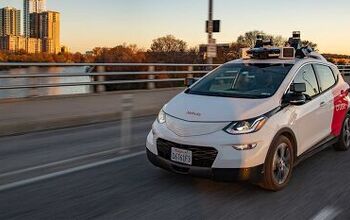Report Knocks "Big Battery" Plug-In Subsidies, Will The DOE Notice?
The main tool for the government’s crusade to get one million plug-in cars on the road by 2015 is the “Qualified Plug-In Electric Vehicle Tax Credit,” a credit that returns between $2,500 and $7,500 to purchasers of a qualifying vehicle. To qualify for the minimum $2,500 credit, a vehicle must have a traction battery with a minimum of four kW/h, and the credit adds an additional $417 in credits for every kW/h above the minimum. Why? Well, you might think that it’s because the DOE has done its research and determined that larger battery packs deliver more social benefits… at least until the 16kW/h limit (the exact size of the Chevy Volt’s battery), where the credit tops out at $7,500. But according to new research by Carnegie Mellon’s Jeremy Michalek, that basic assumption doesn’t appear to be true at all. In fact, his latest paper argues that the government would actually be better off subsidizing smaller, not larger, battery packs.
In an in-depth evaluation [ PDF] of plug-in hybrids (PHEVs), large-battery EVs, smaller-battery EVs, Hybrids and conventional cars, Michalek and his colleagues found that
Current subsidies intended to encourage sales of plug-in vehicles with large capacity battery packs exceed our externality estimates considerably, and taxes that optimally correct for externality damages would not close the gap in ownership cost. In contrast, HEVs and PHEVs with small battery packs reduce externality damages at low (or no) additional cost over their lifetime. Although large battery packs allow vehicles to travel longer distances using electricity instead of gasoline, large packs are more expensive, heavier, and more emissions intensive to produce, with lower utilization factors, greater charging infrastructure requirements, and life-cycle implications that are more sensitive to uncertain, time-sensitive, and location-specific factors. To reduce air emission and oil dependency impacts from passenger vehicles, strategies to promote adoption of HEVs and PHEVs with small battery packs offer more social benefits per dollar spent.
Back in 2009, Michalek made the core of this argument in an interview with Spectrum Magazine
Spectrum: So if you have to make a choice—big or small batteries for plug-in hybrids—which is best?
JM: From what we’ve found, if you have a higher-capacity plug-in, something like the Volt, it could lower greenhouse-gas emissions for some drivers, but that comes at a cost that wouldn’t be paid back by fuel savings. A $100-a-ton carbon tax doesn’t even do it.
On the other hand, a driver who is able to charge frequently would do well to buy a small-capacity plug-in. This person might not care at all about the environment or about the nation’s dependence on foreign oil, yet he or she would still benefit from buying such a vehicle.
Places where the economic, environmental, and national-security objectives are all well aligned—that’s where you’d want to break in a new technology. I would say to carmakers, go after those people. And to consumers: Buy small, charge often.
The Volt would be the poster-boy for Michalek’s critique: it has the minimum battery size needed to claim the full $7,500 tax credit, and yet its creators admit that it was developed for a consumer use profile rather than ultimate efficiency. Whether the Volt was developed to exactly hit the government’s kW/h credit limit, or if the limit was tailored to the Volt isn’t clear… but what is clear is that incentivizing smaller batteries will do more per dollar spent to displace oil. As Michalek tells Bloomberg
It’s not that large battery packs are bad, it’s that they are not providing as many benefits per dollar. Ordinary hybrids increase fuel economy substantially, and the incremental cost of those systems is getting relatively small.
Meanwhile, the timing of this report is very interesting: Reuters reports that the DOE is about to reveal its own research into EV incentives, and will be pushing to spend more money on Obama’s goal of putting a million EVs on the road.
Energy Secretary Steven Chu is due to unveil the results of a major review of research spending on Tuesday, one that could shift research dollars away from clean electricity and biofuels toward electric vehicles and modernizing the power grid.
The first-ever “Quadrennial Technology Review” prioritizes research that can be commercialized within 10 years, and research that could make a substantial dent in oil use and greenhouse gas production in the next two decades.
But will the DOE’s renewed push for EV proliferation reflect the sober analysis of scientists like Michelak, or will they be more wink-nudge games, in which the industry sets the policy agenda? After all, there are already plenty of reasons for the industry to keep electrified automobiles in a high-price ghetto, and the government has thus far been more than happy to play along with that game. But if this country is serious about reducing oil dependence, plug-in technology needs to be proliferated in the most efficient way possible. That means fewer handouts to luxury EV firms like Fisker and Tesla, and a more rational approach to consumer subsidies, as outlined by Michelak.
More by Edward Niedermeyer
Latest Car Reviews
Read moreLatest Product Reviews
Read moreRecent Comments
- Michael Gallagher I agree to a certain extent but I go back to the car SUV transition. People began to buy SUVs because they were supposedly safer because of their larger size when pitted against a regular car. As more SUVs crowded the road that safety advantage began to dwindle as it became more likely to hit an equally sized SUV. Now there is no safety advantage at all.
- Probert The new EV9 is even bigger - a true monument of a personal transportation device. Not my thing, but credit where credit is due - impressive. The interior is bigger than my house and much nicer with 2 rows of lounge seats and 3rd for the plebes. 0-60 in 4.5 seconds, around 300miles of range, and an e-mpg of 80 (90 for the 2wd). What a world.
- Ajla "Like showroom" is a lame description but he seems negotiable on the price and at least from what the two pictures show I've dealt with worse. But, I'm not interested in something with the Devil's configuration.
- Tassos Jong-iL I really like the C-Class, it reminds me of some trips to Russia to visit Dear Friend VladdyPoo.
- ToolGuy New Hampshire

































Comments
Join the conversation
This is yet another example of the government picking winners and losers... and going with the losers.
>>"Whether the Volt was developed to exactly hit the government’s kW/h credit limit, or if the limit was tailored to the Volt isn’t clear" I think its very obvious that the government tailored the limit specifically to subsidize the Volt. GM originally showed the 2007 Volt concept with a 16 KWh battery. GM could not have tailored the car for the rebate, as the rebate didn't exist when the 16 Kwh figure was announced. In 2009, the American Recovery and Reinvestment Act, which introduced the federal tax subsidizes for EVs, didn't pull the 16 Kwh number out of a hat. Obviously, this rebate, which is based on battery size doesn't give any extra benefit to true EVs like the Leaf that has a 50% larger battery, nor PHEVs like the Prius. This rebate is completely tailored for the Volt with the sweet-sweet being Volt's exact battery size. That said, the rebate itself is near useless. The argument presented in this article should be taken a step further, especially considering the Prius PHEV's price. the $2,500 rebate likely has little impact on the Prius PHEV's sales, and the fact it can be made at $32k, and the Leaf not much more than that, indicates that normal market forces would allow these cars to come to market without the aid of rebates. In fact, the only PHEV/EV that is out overpriced is the Volt.